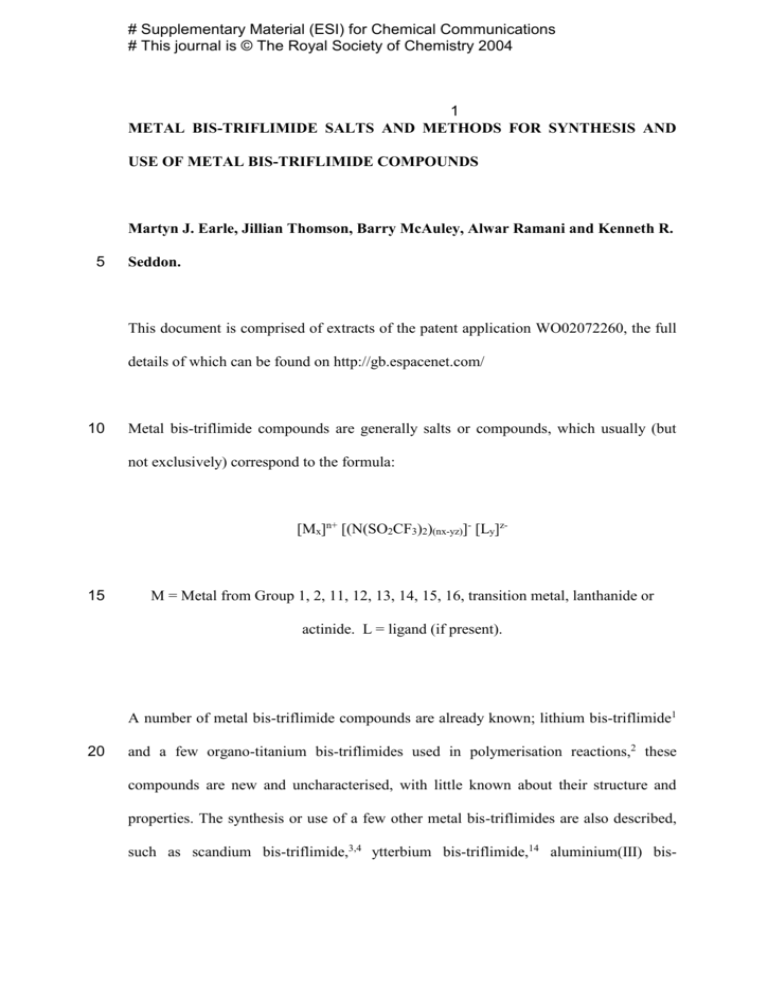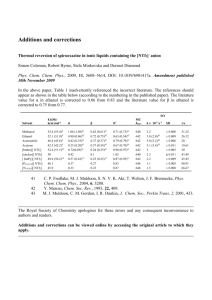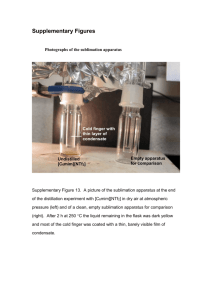Experimental details - Royal Society of Chemistry
advertisement

# Supplementary Material (ESI) for Chemical Communications # This journal is © The Royal Society of Chemistry 2004 1 METAL BIS-TRIFLIMIDE SALTS AND METHODS FOR SYNTHESIS AND USE OF METAL BIS-TRIFLIMIDE COMPOUNDS Martyn J. Earle, Jillian Thomson, Barry McAuley, Alwar Ramani and Kenneth R. 5 Seddon. This document is comprised of extracts of the patent application WO02072260, the full details of which can be found on http://gb.espacenet.com/ 10 Metal bis-triflimide compounds are generally salts or compounds, which usually (but not exclusively) correspond to the formula: [Mx]n+ [(N(SO2CF3)2)(nx-yz)]- [Ly]z- 15 M = Metal from Group 1, 2, 11, 12, 13, 14, 15, 16, transition metal, lanthanide or actinide. L = ligand (if present). A number of metal bis-triflimide compounds are already known; lithium bis-triflimide1 20 and a few organo-titanium bis-triflimides used in polymerisation reactions,2 these compounds are new and uncharacterised, with little known about their structure and properties. The synthesis or use of a few other metal bis-triflimides are also described, such as scandium bis-triflimide,3,4 ytterbium bis-triflimide,14 aluminium(III) bis- # Supplementary Material (ESI) for Chemical Communications # This journal is © The Royal Society of Chemistry 2004 14 triflimide, 2 magnesium bis-triflimide, silver bis-triflimide12 and recently Group 1 bis5 triflimides (Li, Na, K, Br, Cs).6 In this document, metal bis-triflimide compounds are described and methods for their preparation. The use of these new metal bis-triflimide compounds (other than those listed)11-16 are described, and the preparation of some of 5 the described salts11-16 by new and/or improved means is also described. Also, given in this report is the X-ray crystallographic structure of a new metal bis-triflimide salt Zn(N(SO2CF3)2)2 which has a unique structure which is thought to give rise to its excellent catalytic properties. Metal bis-triflimides can be partially or wholly dissolved in the reactants or products of a reaction and act as catalysts. They can also be dissolved 10 in a solvent, such as organic solvents or ionic solvents (ionic liquids or molten salts)7 or supercritical fluids and act as a catalyst or reagent for chemical reactions. This may take place under monophasic, biphasic or polyphasic conditions. SO2CF3 Al + H N H2O - 3+ [Al] SO2CF3 N CO2CF3 SO2CF3 CoCO3 + H N CO2CF3 H2O [Co] 2+ - N Ni(OH)2 + 15 H N CO2CF3 + H2O + CO2 CO2CF3 H2O [Ni] 2+ - 3 SO2CF3 CO2CF3 SO2CF3 + H2 2 SO2CF3 N + 2 H2O CO2CF3 2 # Supplementary Material (ESI) for Chemical Communications # This journal is © The Royal Society of Chemistry 2004 3 Figure 1, Examples of the preparation of metal bis-triflimide compounds. The primary methods for preparing metal bis-triflimide covered by this report are: 5 (1) Metal + hydrogen bis-triflimide (2) Metal carbonate + hydrogen bis-triflimide (3) Metal hydroxide + hydrogen bis-triflimide (4) Metal oxide + hydrogen bis-triflimide The metal bis-triflimide compound is usually made by the interaction of a metal, metal 10 oxide, metal hydroxide, metal carbonate, metal bi-carbonate, metal acetate or other alkanoanoate with bis-trifluoromethanesulphonimide (also known as hydrogen triflimide or hydrogen bis-triflimide) (H-N(SO2CF3)2), in a solvent such which is usually water. Other solvents can be used, such as alcohols, ketones or esters. The metal bis-triflimide compound may also be made by the interaction of hydrogen bis-triflimide and a metal 15 compound in the absence of a solvent. The metal bis-triflimide compounds are obtained in a pure state by evaporation of the solvent, usually by heating (to drive off water or other solvent), especially under vacuum. Further purification is achieved by vacuum distillation or vacuum sublimation 20 of the metal bis-triflimide compound. Purification can also be achieved by some other physical or chemical process, with crystalisation being an example. As implied here metal bis-triflimide compounds are usually (but not always) volatile (see Table 1 for boiling / sublimation points). # Supplementary Material (ESI) for Chemical Communications # This journal is © The Royal Society of Chemistry 2004 4 Table 1, the sublimation temperatures of selected metal bis-triflimide compounds. Metal bis-triflimide Bp / °C at 1 mmHg Mg(NTf2)2 300 Ca(NTf2)2 400 (dec.) Ni(NTf2)2 280 Cu(NTf2)2 180 (dec.) Fe(NTf2)2 280 Ni(NTf2)2 280 Cu(NTf2)2 180 (dec.) Zn(NTf2)2 260 Cd(NTf2)2 350 (dec.) Yb(NTf2)3 270 5 The volatility of metal bis-triflimide salts makes them suitable for vacuum deposition of metals or metal compounds, and is claimed as an invention in this patent. 10 Metal bis-triflimide compounds display catalytic behaviour and catalyse many reactions that are conventionally catalysed by Lewis acids. This makes them suitable for many Lewis acid catalysed or Lewis acid mediated chemical transformations. They possess # Supplementary Material (ESI) for Chemical Communications # This journal is © The Royal Society of Chemistry 2004 5 advantages over Lewis acids such as aluminium(III) chloride in that they do not form excessively strong complexes with the reactants or products of a chemical transformation. Furthermore, catalyst loading can be as low as 1 mol % metal bistriflimide can give rise to quantitative yields in Friedel-Crafts acylation reactions.8 5 These metal bis-triflimide compounds may be soluble or partially soluble or insoluble in the reactants or products (these can act as both solvent and reagent). They may be soluble, insoluble of partially soluble in a molecular solvent or solvents including supercritical solvents, or may be dissolved or suspended in an ionic liquid (molten salt that is in a liquid state at the reaction temperature and usually (but not essentially) 10 molten at or near room temperature – assumed to be 20 °C). The structure of metal bis-triflimide compounds is thought to be similar to that of zinc bis-triflimide whose X-ray crystallographic structure is shown in Figures 2-4. 15 20 Figure 2: The structure of Zn(NTf2)2. # Supplementary Material (ESI) for Chemical Communications # This journal is © The Royal Society of Chemistry 2004 6 5 Figure 3, The structure of Zn(NTf2)2. 10 Figure 4: The structure of Zn(NTf2)2. 15 As can be seen from the structure of zinc(II) bis-triflimide, it is made of two bistriflimide groups coordinating to the metal through the oxygen atoms of the bistriflimide ion (and not the nitrogen atom). The two remaining octahedral coordinating sites on the metal atom, are filled with oxygen atoms from adjacent Zn(NTf2)2 groups. 20 As some of the metal bis-triflimides compounds are volatile, the coordination from adjacent metal bis-triflimide groups may be fairly weak. Example 1. # Supplementary Material (ESI) for Chemical Communications # This journal is © The Royal Society of Chemistry 2004 7 Preparation of magnesium bis-triflimide. Magnesium (0.048 g, 2.0 mmol) was added to a solution of bis-triflimide (HN(SO2CF3)2, 1.12 g, 4.0 mmol) in distilled water (5 g) in a 25 cm3 round bottomed flash equipped with a magnetic stirrer. The mixture was stirred for 1 hour (judged to be 5 complete when the evolution of hydrogen ceased), and was filtered. The water was evaporated on a rotary evaporator, and the magnesium bis-triflimide dried by heating at 150 °C at 1 mmHg for 4 hours in a vacuum drying apparatus, to give a white powder (1.10g, 95 %). The magnesium bis-triflimide was purified by vacuum sublimation at 300 °C at 1 mmHg in a Kugelrohr apparatus. The unpurified magnesium bis-triflimide 10 was found to be a Friedel-Crafts catalyst for the reaction of anisole and benzoyl chloride. The catalytic activity was less than Zn(NTf2)2. Mg(NTf2)2 was found to be a good sulfonation catalyst in the reaction of benzene sulfonyl chloride with chlorobenzene. 15 Figure 5, Magnesium(II) bis-triflimide during the sublimation process. # Supplementary Material (ESI) for Chemical Communications # This journal is © The Royal Society of Chemistry 2004 8 Example 2: Preparation of aluminium(III) bis-triflimide. Aluminium dust (0.030 g, 1.15 mmol) was added to a solution of bis-triflimide 5 (HN(SO2CF3)2, 0.84 g, 3.0 mmol) in distilled water (5 g) in a 25 cm3 round bottomed flash equipped with a magnetic stirrer. This was heated under reflux for 0.5 hours. The mixture was cooled to room temperature and was filtered to remove excess aluminium. The water was evaporated on a rotary evaporator, and the aluminium bis-triflimide dried by heating at 150 °C at 1 mmHg for 4 hours in a vacuum drying apparatus, to give a 10 white powder (0.83 g, 96 %). The unpurified aluminium bis-triflimide was found to be a Friedel-Crafts catalyst for the reaction of anisole or xylene and benzoyl chloride. The catalytic activity was similar to Zn(NTf2)2. Example 3: 15 Preparation of manganese(II) bis-triflimide. Manganese(II) carbonate (0.18 g, 1.6 mmol) was added to a solution of bis-triflimide (HN(SO2CF3)2, 0.84 g, 3.0 mmol) in distilled water (5 g) in a 25 cm3 round bottomed flash equipped with a magnetic stirrer. evolution of CO2 ceased. 20 This was stirred for 0.5 hours (until the The mixture was filtered to remove excess manganese carbonate. The water was evaporated on a rotary evaporator, and the manganese(II) bistriflimide dried by heating at 150 °C at 1 mmHg for 4 hours in a vacuum drying apparatus, to give an almost white powder (0.90 g, 97 %). The manganese(II) bistriflimide was purified by vacuum distillation / sublimation at 280 °C at 1 mmHg in a # Supplementary Material (ESI) for Chemical Communications # This journal is © The Royal Society of Chemistry 2004 9 Kugelrohr apparatus (this temperature and pressure appears to be very close to the triple point of this material ie melting point = boiling point). The unpurified manganese(II) bis-triflimide was found to be an excellent Friedel-Crafts catalyst for the reaction of toluene and benzoyl chloride. The catalytic activity was greater than Zn(NTf2)2. 5 Example 4: Preparation of nickel(II) bis-triflimide. Nickel(II) hydroxide (0.15 g, 1.6 mmol) was added to a solution of bis-triflimide 10 (HN(SO2CF3)2, 0.84 g, 3.0 mmol) in distilled water (5 g) in a 25 cm3 round bottomed flash equipped with a magnetic stirrer. This was stirred for 1 hour (until the hydroxide mostly dissolved to give a green solution). The mixture was filtered to remove excess nickel hydroxide. The water was evaporated on a rotary evaporator, and the nickel(II) bis-triflimide dried by heating at 150 °C at 1 mmHg for 4 hours in a vacuum drying 15 apparatus, to give a very pale yellow powder (0.90 g, 97 %). The nickel(II) bistriflimide was purified by vacuum distillation / sublimation at 280 °C at 1 mmHg in a Kugelrohr apparatus (see Figure 6). The unpurified nickel(II) bis-triflimide was found to be an excellent Friedel-Crafts catalyst for the reaction of toluene and benzoyl chloride. The catalytic activity was greater than Zn(NTf2)2. 20 # Supplementary Material (ESI) for Chemical Communications # This journal is © The Royal Society of Chemistry 2004 10 Figure 6. Vacuum sublimed Ni(NTf2)2 Example 5: 5 Preparation of cobalt(II) bis-triflimide. Cobalt(II) carbonate (0.19 g, 1.6 mmol) was added to a solution of bis-triflimide (HN(SO2CF3)2, 0.84 g, 3.0 mmol) in distilled water (5 g) in a 25 cm3 round bottomed flash equipped with a magnetic stirrer. This was stirred for 1 hour (until the evolution of CO2 ceased to give a pink solution). The mixture was filtered to remove excess 10 nicker hydroxide. The water was evaporated on a rotary evaporator, and the cobalt(II) bis-triflimide dried by heating at 150 °C at 1 mmHg for 4 hours in a vacuum drying apparatus, to give a pale pink powder (0.90 g, 97 %). The cobalt(II) bis-triflimide was purified by vacuum distillation / sublimation at 300 °C at 1 mmHg in a Kugelrohr apparatus (see Figure 7). The unpurified cobalt(II) bis-triflimide was found to be an 15 excellent Friedel-Crafts catalyst for the reaction of toluene and benzoyl chloride. The catalytic activity was greater than Zn(NTf2)2. Also this is one of the few Friedel-Crafts acylation catalysts that was found to catalyse the acylation of chlorobenzene with benzoyl chloride. # Supplementary Material (ESI) for Chemical Communications # This journal is © The Royal Society of Chemistry 2004 11 Figure 7. Vacuum sublimed Co(NTf2)2 5 Example 6: Preparation of copper(II) bis-triflimide. Copper(II) carbonate (0.20 g, 1.6 mmol) was added to a solution of bis-triflimide (HN(SO2CF3)2, 0.84 g, 3.0 mmol) in distilled water (5 g) in a 25 cm3 round bottomed flash equipped with a magnetic stirrer. This was stirred for 1 hour (until the evolution 10 of CO2 ceased to give a blue/green solution). The mixture was filtered to remove excess copper(II) carbonate. The water was evaporated on a rotary evaporator, and the copper(II) bis-triflimide dried by heating at 150 °C at 1 mmHg for 4 hours in a vacuum drying apparatus, to give a very pale green / blue powder (0.89 g, 95 %). The copper(II) bis-triflimide was purified by vacuum distillation / sublimation at 180 °C at 1 mmHg in 15 a Kugelrohr apparatus (partial decomposition occurs during sublimation and approximately half the copper(II bis-triflimide is lost). The unpurified copper(II) bistriflimide was found to be a Friedel-Crafts catalyst for the reaction of toluene, anisole # Supplementary Material (ESI) for Chemical Communications # This journal is © The Royal Society of Chemistry 2004 12 and xylene with benzoyl chloride (activity was less than Zn(NTf2)2) . The copper(II) bis-triflimide was also found to be a good Friedel-Crafts alkylation catalyst. Example 7: 5 Preparation of zinc(II) bis-triflimide. Zinc (0.13 g, 2.0 mmol) was added to a solution of bis-triflimide (HN(SO2CF3)2, 0.84 g, 3.0 mmol) in distilled water (5 g) in a 25 cm3 round bottomed flash equipped with a magnetic stirrer. This was stirred for 1 hour (until the evolution of H2 ceased to give a colourless solution). The mixture was filtered to remove excess zinc. The water was 10 evaporated on a rotary evaporator, and the zinc(II) bis-triflimide dried by heating at 150 °C at 1 mmHg for 4 hours in a vacuum drying apparatus, to give a white crystals (0.91 g, 97 %). One of these crystals was submitted for x-ray crystallographic analysis and its structure shown in Figures 2-4. The zinc(II) bis-triflimide was purified by vacuum distillation / sublimation at 260 °C at 1 mmHg in a Kugelrohr apparatus. The unpurified 15 zinc(II) bis-triflimide was found to be a good Friedel-Crafts catalyst for the reaction of toluene, anisole and xylene with benzoyl chloride, and benzoic acid with xylene. Also this is one of the few Friedel-Crafts acylation catalysts that was found to catalyse the acylation of chlorobenzene with benzoyl chloride. 20 Example 8: Preparation of ytterbium(III) bis-triflimide. I am guessing at the procedure – Jillian has the details. # Supplementary Material (ESI) for Chemical Communications # This journal is © The Royal Society of Chemistry 2004 13 Ytterbium oxide (0.31 g, 0.008 mmol) was added to a solution of bis-triflimide (HN(SO2CF3)2, 0.84 g, 3.0 mmol) in distilled water (5 g) in a 25 cm3 round bottomed flash equipped with a magnetic stirrer. This was heated under reflux for 1 hour. The mixture was filtered to remove excess ytterbium oxide. The water was evaporated on a 5 rotary evaporator, and the ytterbium(III) bis-triflimide dried by heating at 150 °C at 1 mmHg for 4 hours in a vacuum drying apparatus, to give a white crystals (? g, ? %). The ytterbium(III) bis-triflimide was purified by vacuum distillation / sublimation at 270 °C at 1 mmHg in a Kugelrohr apparatus. The unpurified ytterbium(III) bis-triflimide was found to be a Friedel-Crafts catalyst for the reaction of anisole and benzoic anhydride or 10 benzoyl chloride with toluene. It was found to have similar activity to the Zn(NTf2)2 salt. Example 9: 15 Calcium Bis-triflimide 1.0 g of calcium(II) carbonate was suspended in 50 mL of water, to which freshly prepared HNTf2 (5.6 g) was added and stirred at room temperature for 24 hours. The reaction mixture was filtered and the filtrate was concentrated on a rotary evaporator and dried under vacuum (1 mmHg) for 4 hours at 150 °C. The unpurified calcium bis- 20 triflimide was found to display poor catalytic activity in Friedel-Crafts reactions. Example 10: Strontium(II) Bis-triflimide # Supplementary Material (ESI) for Chemical Communications # This journal is © The Royal Society of Chemistry 2004 14 1.0g of strontium(II) carbonate was suspended in 50 mL of water, to which freshly prepared HNTf2 (3.8 g) was added and stirred at room temperature for 24 hours. The reaction mixture was filtered and the filtrate was concentrated on a rotary evaporator and dried under vacuum (1 mmHg) for 4 hours at 150 °C. The unpurified calcium(II) 5 bis-triflimide was found to display poor catalytic activity in Friedel-Crafts reactions, but was slightly more active than the calcium analogue. Example 11: Barium Bis-triflimide 10 1.0g of Barium(II) carbonate was suspended in 50 mL of water, to which freshly prepared HNTf2 (2.8 g) was added and stirred at room temperature for 24 hours. The reaction mixture was filtered and the filtrate was concentrated on a rotary evaporator and dried under vacuum (1 mmHg) for 4 hours at 150 °C. The unpurified barium(II) bis-triflimide was found to display some catalytic activity in Friedel-Crafts reactions, 15 and was more active than the calcium and strontium analogues. Example 12: Tin(II) bis-triflimide procedure 1 20 Tin metal (5.0 g, 99.9 % purity) lumps were suspended in water (50 mL) and hydrogen bis-triflimide (HNTf2) (10 g) was added. This mixture was heated under reflux for 72 hours. The resultant mixture was cooled, filtered and concentrated on a rotary evaporator to give a colourless solution that crystalised on standing. The off white # Supplementary Material (ESI) for Chemical Communications # This journal is © The Royal Society of Chemistry 2004 15 crystals were heated at 150 °C at 1 mmHg to remove the residual water and hydrogen bis-triflimide. The unpurified tin(II) bis-triflimide was found to display catalytic activity in Friedel-Crafts reactions (eg 1% Sn(NTf2)2 + toluene + benzoyl chloride gave 99 % yield after 48 hours under reflux). The reactivity was similar to zinc bis-triflimide. 5 Example 13: Tin(II) Bis-triflimide procedure 2 Tin(II) oxide (1.0 g) powder was suspended in water (50 mL) and hydrogen bis10 triflimide (HNTf2) (5.0 g) was added. This mixture was heated under reflux for 48 hours. The resultant slurry was cooled, filtered and concentrated on a rotary evaporator to give a colourless solution that gave an off white precipitate on standing. The off white precipitate was heated at 150 °C at 1 mmHg to remove the residual water and hydrogen bis-triflimide. The unpurified tin(II) bis-triflimide was found to display 15 catalytic activity in Friedel-Crafts reactions (eg 1% Sn(NTf2)2 + toluene + benzoyl chloride gave 99 % yield after 48 hours under reflux). Example 14: Lead(II) Bis-triflimide 20 13.0g of lead(II) carbonate was taken in 50 mL of water, to which freshly prepared 28.0g of HNTf2 was added and stirred at room temperature for 24 hours. The reaction mixture was filtered and the filtrate was concentrated on a rotary evaporator and dried under vacuum (1 mmHg) for 3 days at 120 °C. The unpurified lead(II) bis-triflimide was # Supplementary Material (ESI) for Chemical Communications # This journal is © The Royal Society of Chemistry 2004 16 found to display good catalytic activity in Friedel-Crafts reactions (eg 1% Pb(NTf2)2 + toluene + benzoyl chloride gave 99 % yield after 48 hours under reflux). The catalytic activity was better than zinc(II) bis-triflimide. 5 Example 15: Iron(II) Bis-triflimide Iron metal (5.0 g, 99.95 % purity) lumps were suspended in water (50 mL) and hydrogen bis-triflimide (HNTf2) (10 g) was added. This mixture was heated under reflux for 72 hours. The resultant slurry was cooled, filtered and concentrated on a rotary evaporator 10 to give a pale yellow solution that crystalised on standing. The pale yellow crystals were heated at 150 °C at 1 mmHg to remove the residual water and hydrogen bistriflimide. Example 16: 15 Iron(III) Bis-triflimide This compound can be isolated in two forms as either cream coloured crystals (thought to be Fe(NTf2)2(OH)(OH2)) or a brown solid (thought to be FeO(NTf2)). To a solution of iron(III) nitrate (10 g) in water was added sodium hydroxide solution (1 M) until a brown precipitate had formed. The precipitate of hydrated iron(III) hydroxide was 20 collected by vacuum filtration and washed with water. The precipitate (approximately 5 g) was suspended in distilled water and excess hydrogen bis-triflimide was added (20 g). The precipitate slowly dissolved to give a clear pale brown solution. The solution was filtered and concentrated on a rotary evaporator, and transferred to a kugelrohr # Supplementary Material (ESI) for Chemical Communications # This journal is © The Royal Society of Chemistry 2004 17 distillation apparatus. The unreacted hydrogen bis-triflimide was distilled out at 100 °C, 1 mmHg, leaving a cream coloured crystalline solid of hydrated iron(III) bis-triflimide. Further heating at 170 °C, 1 mmHg for 4 hours, resulted in the evolution of hydrogen bis-triflimide, and a brown solid was formed (FeO(NTf2)). Both of these solids were 5 found to be excellent Friedel-Crafts catalysts for the reaction of toluene with benzoyl chloride at 1 mol% concentration. 1 J. L. Nowinski P. Lightfoot P. G. Bruce, J. Mat. Chem., 1994, 4, 1579-1580. 2 R. Claessen, S. Ngo, J. T. Welch, World Patent WO 9940124, 1999. 3 K. Ishihara, Y. Karumi, M. Kubota, H. Yamamoto, Synlett, 1996, 839-841. 4 K. Mikami, O. Koiera, Y. Motoyama, H. Sakaguchi, M. Maruta, Synlett, 1996, 171172. 5 P. A. Grieco, S. T. Handy, Tetrahedron Letters, 1997, 38, 2645-2648. 6 EP 1122239 A2 Process for preparing sulfonylimide compounds and EP 1122240 A2 Process for preparing sulfonylimide compounds. 7 8 M. J. Earle, K. R. Seddon, Pure App. Chem., 2000, 74, 1394. Methods For The Use Of Metal Bis-triflimide Catalysts For The Catalysis Of Chemical Reactions. Martyn J. Earle, Jillian M. Thompson, Barry J. McAuley and Kenneth R. Seddon, UK patent application.







